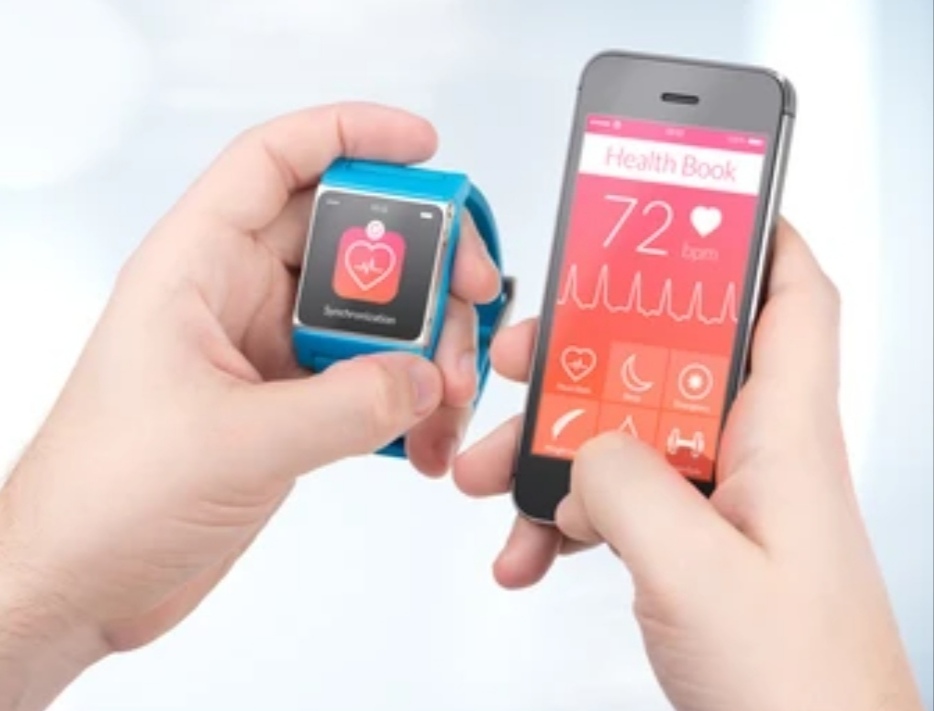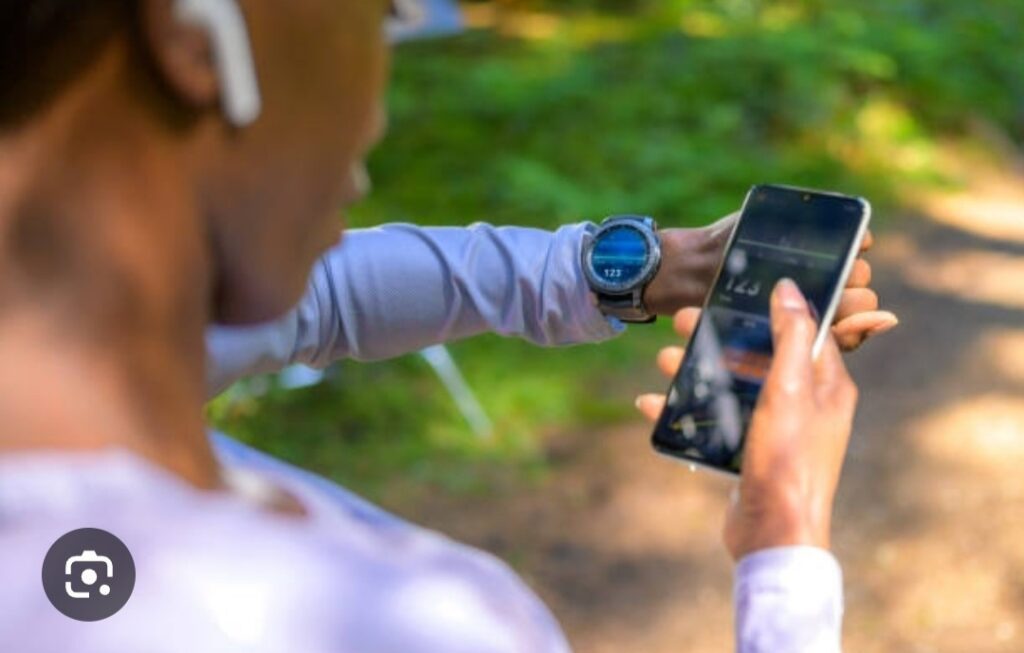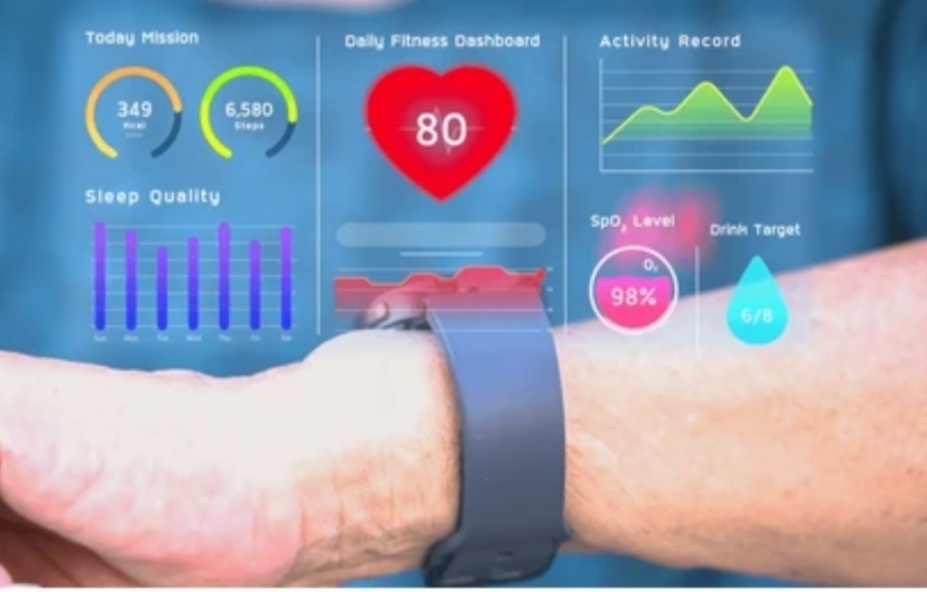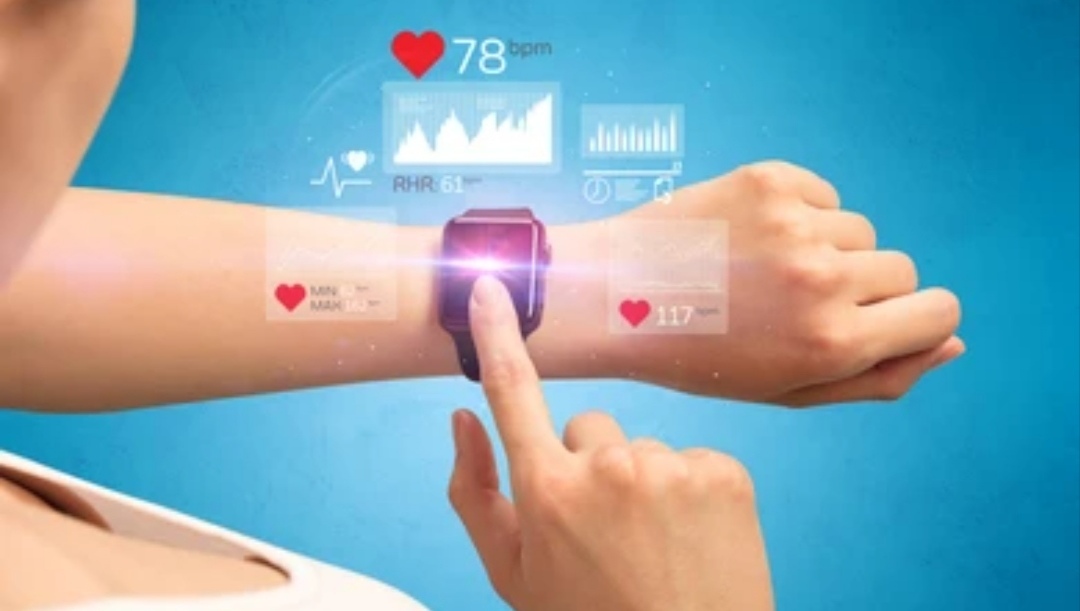Wearable Tech for Fitness
In the fast-paced world of fitness and wellness, wearable technology has revolutionized the way we track and improve our health.
From monitoring heart rates to providing real-time insights into sleep patterns, fitness wearables empower users to take control of their well-being like never before.
The demand for best wearable tech for fitness continues to surge, thanks to their ability to deliver actionable health data and seamless integration with our daily routines.
As we step into 2025, let’s explore how wearable fitness technology has evolved and why it is essential for achieving your health and fitness goals.

The Evolution of Wearable Fitness Technology
Wearable fitness technology has come a long way since its inception.
In the early days, fitness trackers were simple pedometers designed to count steps.
Fast forward to today, and we have devices that not only monitor steps but also track sleep quality, blood oxygen levels, and even stress.
The integration of AI and advanced sensor technology has been a game-changer, allowing devices to provide accurate and personalized health insights.
Wearables now serve as mini health assistants, offering real-time feedback and helping users make informed decisions about their fitness routines.
Another significant development is the rise of smart rings and glasses, complementing traditional smartwatches and fitness bands.
With wearable tech evolving rapidly, we are witnessing innovations such as skin temperature sensors, ECG monitors, and blood pressure tracking, bringing hospital-grade health metrics to your wrist.
The rise of health tech industry has also driven innovation.
Companies are leveraging these strategies to enhance user engagement, making wearables not just tools but lifestyle companions.
Importance of Fitness and Health Tracking
Tracking fitness and health metrics is no longer a luxury—it’s a necessity for leading a healthier life.
- Enhanced Awareness: Wearable devices increase awareness about your health by tracking vital stats such as heart rate, calories burned, and sleep quality. This data helps you understand your body better and take timely action.
- Goal Setting and Achievement: With fitness wearables, you can set realistic health goals, monitor progress, and stay motivated to achieve them. Whether it’s weight loss, muscle building, or simply staying active, wearables keep you accountable.
- Chronic Condition Management: Devices like the [Fitbit Charge 6] and [Garmin Venu 3] offer features like blood oxygen tracking and irregular heartbeat detection, which are particularly beneficial for individuals managing chronic conditions.
- Stress Management: Advanced wearables now come equipped with stress monitoring tools. These tools offer breathing exercises and relaxation tips, ensuring mental well-being alongside physical fitness.
- Sleep Optimization: Quality sleep is a cornerstone of health. Wearables track sleep stages, provide insights into sleep patterns, and suggest improvements, helping you wake up refreshed and energized.
By integrating wearables into your daily routine, you unlock a treasure trove of data that helps you make informed decisions about your health.
The insights gained empower you to lead a balanced lifestyle and prevent potential health issues before they escalate.
[Ready to revolutionize your fitness journey? Explore the [latest fitness wearables] now and take the first step toward a healthier you!]
Key Features to Consider in Fitness Wearables
Fitness wearables come in all shapes and sizes, but selecting the right one requires careful consideration of its features.
To make an informed choice, let’s break down the most critical aspects that make a wearable tech device stand out.

Health Monitoring Capabilities
One of the standout features of modern fitness wearables is their ability to monitor a wide range of health metrics.
- Heart Rate Monitoring:
Most fitness wearables, like the [Apple Watch Series 10] and [Garmin Forerunner 965], offer continuous heart rate tracking. This feature helps users stay within their target heart rate zones during workouts and provides valuable insights into resting heart rates, an essential marker of overall cardiovascular health. - Sleep Tracking:
Sleep is integral to recovery and overall well-being. Devices like the [Oura Ring 4] provide detailed sleep analysis, breaking down light, deep, and REM sleep stages. Advanced wearables even offer tips to improve sleep quality based on data trends. - Blood Oxygen Levels:
Tracking blood oxygen levels (SpO2) is no longer reserved for medical-grade devices. Wearables such as the [Samsung Galaxy Watch Ultra] allow users to monitor oxygen saturation, a critical metric for understanding respiratory health. - Stress and Recovery Monitoring:
Stress management features, like guided breathing exercises and recovery suggestions, are becoming standard. These features not only improve physical health but also promote mental well-being. - Additional Health Sensors:
Innovations like ECG monitors, skin temperature sensors, and hydration trackers are now part of the latest wearable devices. These advancements reflect the rapid evolution of wearable tech, making them indispensable tools for holistic health tracking.
[Discover wearables with advanced health monitoring features that empower your fitness journey].
Activity Tracking
Fitness wearables are designed to help users stay active, offering comprehensive activity-tracking features.
- Steps and Calorie Tracking:
Most devices accurately count steps and estimate calories burned, making them perfect for users aiming to increase daily movement. - Workout Detection:
Advanced wearables automatically detect different types of workouts, from running and cycling to yoga and swimming. The [Fitbit Charge 6], for example, offers over 20 exercise modes to track specific activities effectively. - GPS Functionality:
GPS tracking is crucial for outdoor enthusiasts. Devices like the [Garmin Venu 3] provide accurate route mapping, pace monitoring, and elevation data, making them ideal for runners, hikers, and cyclists. - Active Minute Goals:
Many wearables set personalized activity goals, encouraging users to meet daily fitness targets. This feature is particularly motivating for beginners seeking to develop consistent exercise habits.
[Take control of your fitness goals with wearables that track every move. Choose yours today!]
Battery Life
A wearable’s battery life can make or break the user experience.
- Long-Lasting Power:
Devices with extended battery life, like the [Amazfit GTR 4], eliminate the hassle of frequent charging. Some devices can last up to two weeks on a single charge, perfect for those with busy schedules or extended outdoor activities. - Fast Charging:
Many premium wearables now support quick charging, providing several hours of use with just a few minutes of charging time. - Battery Optimization Features:
Features like power-saving modes ensure that your device lasts longer during intensive use, such as GPS tracking or workout sessions.
Compatibility and Connectivity
Seamless integration with your existing devices and apps is a key consideration.
- Smartphone Integration:
Wearables should be compatible with both iOS and Android platforms. Devices like the [Apple Watch] integrate flawlessly with iPhones, while others like the [Samsung Galaxy Watch Ultra] cater to Android users. - Fitness Apps:
Many wearables sync with popular apps like Strava, MyFitnessPal, and Apple Health, allowing users to track progress in one place. - Bluetooth and Wi-Fi Connectivity:
Modern wearables offer reliable Bluetooth and Wi-Fi connections, ensuring smooth syncing and updates. - Voice Assistance:
Devices with voice assistants like Siri, Alexa, or Google Assistant provide hands-free convenience, enhancing user experience.
Design and Comfort
A wearable’s design plays a significant role in its usability.
- Lightweight and Ergonomic:
Wearables should be comfortable for all-day use. Devices like the [Oura Ring 4] are lightweight and non-intrusive, making them ideal for those who prefer discreet options. - Customizable Styles:
Many wearables offer interchangeable bands and customizable watch faces, allowing users to match their devices to their style. - Durability:
Wearables built with durable materials, like stainless steel or reinforced polymer, are better suited for active lifestyles. Look for water-resistant models for swimming or outdoor use. - Display Quality:
Bright, high-resolution displays improve readability in different lighting conditions. AMOLED or OLED screens, like those on the [Garmin Venu 3], offer vibrant visuals for a premium experience.
[Find the perfect wearable that combines style, comfort, and functionality].
By focusing on these key features, you can select a fitness wearable that aligns perfectly with your health goals, lifestyle, and budget.
Don’t settle for less—invest in a device that empowers your journey to better health and fitness.
Top Wearable Devices for Fitness and Health Tracking in 2025
With an ever-growing range of fitness wearables, it’s essential to find a device that aligns with your lifestyle and goals.
Here’s a detailed breakdown of the best options available in 2025 to help you make an informed choice.

Smartwatches
Smartwatches dominate the fitness wearable market due to their versatility, functionality, and stylish designs.
They not only track your health and fitness metrics but also act as an extension of your smartphone.
Apple Watch Series 10
The Apple Watch Series 10 sets the standard for premium smartwatches. With enhanced health metrics and seamless iOS integration, it’s a favorite among iPhone users.
- Features:
- Advanced health tracking, including blood oxygen levels, ECG monitoring, and irregular heart rhythm notifications.
- Sleep tracking with insights to improve sleep quality.
- Activity tracking with detailed metrics for workouts, steps, and calories burned.
- Fall detection and emergency SOS for added safety.
- Upgraded processor ensures smoother performance and faster app loading times.
- Why It Stands Out:
- Seamlessly integrates with [Apple Health] and other fitness apps, making it easy to track your fitness journey.
- Fitness+ integration allows users to follow personalized workouts right on their watch.
- Who It’s For:
Ideal for [iPhone users seeking a comprehensive health and fitness tracker] with unparalleled software and hardware synergy.
Samsung Galaxy Watch Ultra
The Samsung Galaxy Watch Ultra is a top contender in the Android smartwatch space, offering advanced fitness tracking and robust durability.
- Features:
- Comprehensive activity tracking with pre-set modes for various workouts.
- Advanced GPS for accurate route tracking during outdoor activities.
- Robust battery life, lasting up to 72 hours on a single charge.
- Body composition analysis, providing insights into fat percentage, muscle mass, and more.
- Stress monitoring and guided breathing exercises.
- Why It Stands Out:
- Military-grade durability ensures it can withstand extreme conditions, making it ideal for adventure enthusiasts.
- Integrates with Samsung Health and Google Fit, providing a centralized view of health metrics.
- Who It’s For:
Perfect for [Samsung phone users and outdoor adventurers] who need a rugged yet feature-rich device.
Garmin Venu 3
The Garmin Venu 3 is a premium smartwatch tailored for fitness enthusiasts who demand in-depth metrics and wellness insights.
- Features:
- Advanced health tracking, including heart rate variability, stress levels, and sleep coaching.
- A vibrant AMOLED display that remains readable even in direct sunlight.
- Body Battery Energy Monitoring, which shows how much energy you have for the day.
- Pre-loaded workout plans and animated on-screen exercises.
- Long battery life, lasting up to 10 days in smartwatch mode.
- Why It Stands Out:
- Offers in-depth wellness features like meditation guides and menstrual cycle tracking.
- Sleep coaching provides actionable insights for improving rest and recovery.
- Who It’s For:
Best suited for [fitness enthusiasts seeking detailed metrics and a holistic approach to health tracking].
Key Takeaways
These top smartwatches for 2025 cater to diverse needs and preferences.
Whether you’re an iPhone user looking for seamless integration, a Samsung enthusiast seeking durability, or a fitness buff demanding advanced metrics, there’s a perfect match for you.
[Discover the ultimate fitness wearable for your goals. Check out our top picks now!]
Fitness Trackers
Fitness trackers are ideal for individuals who prefer compact, lightweight devices that focus on core health and activity metrics without the additional complexity of a smartwatch.
Here are some of the best fitness trackers in 2025 to help you achieve your health and fitness goals.
Fitbit Charge 6
The Fitbit Charge 6 continues Fitbit’s legacy of providing user-friendly and highly reliable fitness tracking solutions.
- Features:
- Tracks steps, calories burned, heart rate, and sleep patterns with accuracy.
- Enhanced workout modes to monitor various activities like running, cycling, and yoga.
- SpO2 sensor and stress management tools for holistic health tracking.
- A simple, intuitive interface makes it easy to navigate and use daily.
- Long battery life of up to 7 days on a single charge.
- Why It Stands Out:
- Integration with Fitbit Premium offers personalized health insights and advanced analytics.
- Supports for fitness brands, helping users easily share progress on social media platforms and fitness apps.
- Who It’s For:
Perfect for [beginners and casual users] looking for an affordable yet feature-packed device.
Amazfit GTR 4
The Amazfit GTR 4 is a budget-friendly all-rounder that doesn’t compromise on features or performance.
- Features:
- Tracks over 150 sports modes, making it versatile for various activities.
- Includes heart rate monitoring, SpO2 tracking, and stress management features.
- Exceptional battery life lasting more than 10 days on regular usage.
- Equipped with a large AMOLED display for easy data visualization.
- Built-in GPS for precise outdoor activity tracking.
- Why It Stands Out:
- Affordable pricing makes it accessible to a wider audience.
- Syncs effortlessly with popular health apps, providing detailed progress reports.
- Offers a lightweight design, ensuring comfort throughout the day.
- Who It’s For:
Ideal for [budget-conscious users] who want a reliable fitness tracker without breaking the bank.
Garmin Forerunner 965
The Garmin Forerunner 965 is a premium fitness tracker tailored for serious athletes and runners.
- Features:
- Tracks advanced running metrics such as VO2 max, lactate threshold, and training load.
- Offers a high fitness impact score, helping athletes optimize their performance.
- Exceptional battery life of up to 20 days in smartwatch mode and 31 hours in GPS mode.
- Provides built-in maps and navigation tools for outdoor enthusiasts.
- Includes a recovery advisor, guiding users on when to rest and when to train.
- Why It Stands Out:
- Specifically designed for athletes, ensuring precise and actionable insights.
- Compatible with Garmin Connect, offering a centralized platform for detailed analysis and goal tracking.
- Durability and water resistance make it suitable for intense outdoor activities.
- Who It’s For:
Best suited for [athletes and runners] aiming to improve their performance with detailed analytics.
Final Thoughts on Fitness Trackers
Fitness trackers are the perfect solution for anyone seeking a focused and compact way to monitor their health and fitness metrics.
Whether you’re a beginner exploring healthier habits or a seasoned athlete aiming to fine-tune your performance, there’s a fitness tracker designed just for you.
[Find your ideal fitness tracker today and elevate your health journey with ease!]
Smart Rings
Smart rings have redefined the world of wearable technology by offering a sleek and compact way to monitor health and fitness.
Unlike bulkier wearables like smartwatches and fitness bands, smart rings provide a discreet option for continuous tracking, making them an ideal choice for individuals seeking convenience and style.
Oura Ring 4
The Oura Ring 4 is one of the most advanced and stylish smart rings on the market today, focusing on sleep, recovery, and holistic health monitoring. Its compact design is packed with cutting-edge features that make it a top choice for both tech enthusiasts and casual users alike.
- Features That Make Oura Ring 4 Stand Out
- Comprehensive Sleep Tracking: Monitors sleep stages (deep, light, REM) and provides detailed insights to help users optimize their rest.
- Recovery Insights: Tracks heart rate variability (HRV), respiratory rate, and body temperature to measure how well your body is recovering.
- Readiness Score: Offers a daily score to help users understand how prepared their body is for physical activity.
- Compact and Durable: Water-resistant and made with durable materials, the Oura Ring 4 is designed for long-term use.
- Battery Life: Lasts up to a week on a single charge, ensuring uninterrupted tracking.
- Why Choose Oura Ring 4 Over Other Wearables?
- Discreet and Stylish Design: Perfect for users who prefer a low-profile device that doesn’t compromise on aesthetics.
- 24/7 Health Monitoring: Continuously tracks vital health metrics without requiring constant attention.
- Seamless Integration: Syncs effortlessly with the Oura app, providing an intuitive interface for data visualization.
- Compatibility: Works with popular health and fitness apps, making it an excellent addition to existing wellness routines.
- Who Should Use Oura Ring 4?
- Ideal for busy professionals who want a discreet way to track their health.
- Perfect for individuals focusing on improving sleep quality and recovery.
- A great option for those who prefer minimalistic designs without compromising on functionality.
- How It Aligns with Tech
- Health tech brands can leverage Oura Ring 4 by showcasing its unique features and how it empowers users to take control of their wellness journey.
- Using targeted ads and influencer partnerships, companies can highlight the ring’s sleek design and advanced features to appeal to a broader audience.
Smart Rings: A Game-Changer in Wearable Tech
The Oura Ring 4 proves that powerful health monitoring tools don’t have to be bulky or inconvenient. Its emphasis on sleep, recovery, and overall health makes it a standout choice for anyone serious about wellness.
[Discover the revolutionary benefits of the Oura Ring 4 today and elevate your health tracking experience! Click here to learn more.]
Emerging Trends in Wearable Fitness Technology
Wearable fitness technology is advancing rapidly, driven by consumer demand for more accurate, personalized, and integrated solutions.
In 2025, key trends are shaping the future of this industry, combining cutting-edge technology with seamless health monitoring to reach a broader audience.

Integration with Health Services
One of the most exciting developments in wearable fitness technology is the partnership between wearable manufacturers and healthcare providers.
This trend aims to enhance health monitoring capabilities and bridge the gap between consumer fitness tracking and professional medical insights.
- Key Features of Health Service Integration
- Real-Time Data Sharing: Wearables now sync with electronic health records (EHRs), enabling healthcare providers to monitor patients remotely.
- Telemedicine Support: Devices like smartwatches and fitness bands allow users to share vital signs such as heart rate, blood oxygen levels, and sleep patterns directly with their doctors.
- Emergency Assistance: Advanced wearables can detect irregular heart rhythms or falls and notify emergency contacts or healthcare services immediately.
- Why This Matters
- Improves the quality of care for users with chronic conditions by providing continuous data monitoring.
- Enables early detection of health issues, potentially saving lives.
- Reduces the need for frequent doctor visits, making healthcare more accessible and convenient.
- Promoting Health Service Integration
- Health-focused companies can use targeted campaigns to emphasize the life-saving potential of wearables integrated with professional healthcare.
- Highlighting customer success stories and testimonials can build trust and credibility in this emerging trend.
Advanced Sensor Technology
The next frontier for wearable fitness devices lies in advanced sensor technology, which significantly improves the accuracy and scope of health metrics tracking.
- Innovative Sensors Changing the Game
- Bioimpedance Sensors: Measure body composition, hydration levels, and muscle mass, providing detailed insights into physical health.
- PPG and ECG Sensors: Detect irregular heart rhythms and monitor cardiovascular health with medical-grade accuracy.
- Sweat Sensors: Analyze sweat composition to measure hydration, stress levels, and even glucose levels for diabetic users.
- Thermal Sensors: Track body temperature fluctuations to detect illness or menstrual cycle patterns.
- Impact on User Experience
- Users can rely on their devices for highly accurate health data, increasing trust and adoption rates.
- Advanced metrics enable users to make more informed decisions about their fitness and wellness routines.
- How Wearable Devices Come Into Play
- Wearable tech brands can leverage these advancements by showcasing the innovative sensors and their unique capabilities.
- Using engaging video content and interactive infographics can effectively demonstrate the benefits of these sensors to a broader audience.
Personalized Health Insights
Wearables are no longer just trackers—they are personalized health coaches that use AI-driven insights to provide actionable recommendations tailored to each user’s unique needs.
- Features of Personalized Health Insights
- Adaptive Fitness Goals: Devices analyze user performance and adjust fitness targets accordingly.
- Dietary Recommendations: Based on activity levels and calorie burn, some wearables offer meal suggestions to maintain optimal nutrition.
- Stress Management Tools: AI algorithms detect stress patterns and recommend breathing exercises or meditation practices.
- Sleep Optimization Tips: Devices provide customized feedback to improve sleep quality based on sleep cycle analysis.
- Why Personalization Is Key
- Users feel more engaged and motivated when their device provides tailored advice instead of generic metrics.
- Personalized recommendations improve adherence to fitness goals and health routines.
- Advanced AI ensures that the device evolves with the user, keeping the experience dynamic and relevant.
- Leveraging Wearable Devices for Personalized Insights
- Highlighting personalization features in advertising can set a brand apart from competitors.
- Offering free trials or demo videos that showcase AI-driven insights can attract potential customers and drive conversions.
The Future of Wearable Fitness Technology
These emerging trends—integration with health services, advanced sensor technology, and personalized health insights—are setting a new standard for wearable devices in 2025.
By focusing on user-centric features and leveraging innovative wearable devices, wearable tech brands can continue to capture the market and empower users to take control of their health like never before.
[Discover the latest wearable fitness technology trends today and find the perfect device to elevate your health journey. Click here to explore more!]
How to Choose the Right Wearable for Your Needs
Choosing the perfect wearable device can be challenging, especially with the multitude of options available in the market.
Understanding your priorities, budget, and compatibility needs is crucial to make an informed decision.
Here’s a step-by-step guide to help you pick a wearable that aligns with your lifestyle and goals.

Assessing Your Fitness Goals
Your fitness goals should be the foundation for selecting a wearable device.
Whether you’re aiming to improve your workouts, monitor health metrics, or simply track daily activities, your goals will determine the features you need.
- Determine Your Primary Objectives
- Weight Loss: Choose a wearable with calorie tracking, heart rate monitoring, and activity tracking to measure progress.
- Improved Workouts: Devices with advanced metrics like VO₂ max, recovery time, and heart rate zones are ideal for serious athletes.
- Health Monitoring: Look for wearables that offer sleep tracking, stress monitoring, and continuous heart rate analysis.
- General Activity Tracking: Step counters, calorie trackers, and reminders to move are perfect for casual users.
- Specialized Features to Consider
- Advanced Metrics for Athletes: Metrics like cadence, stride length, and lactate threshold analysis can optimize performance.
- Waterproofing for Swimmers: Devices with swim tracking capabilities, like laps and stroke recognition, are essential.
- Stress and Recovery Insights: AI-driven wearables provide feedback to balance activity and rest, preventing burnout.
- How Wearable Tech Influence Choices
- Companies often highlight specific features to appeal to niche audiences. Understanding how marketing strategies align with your needs can help filter out unnecessary options.
- Reviews, testimonials, and influencer partnerships often emphasize fitness goals to resonate with potential buyers.
Budget Considerations
Price is a major factor when purchasing a wearable, but balancing cost with desired functionalities ensures you get the best value.
- Set a Realistic Budget
- Entry-level wearables start as low as $50 but may lack advanced features.
- Mid-range devices ($100–$250) often include GPS, sleep tracking, and heart rate monitoring.
- Premium wearables ($300+) offer advanced metrics, sleek designs, and compatibility with health services.
- Evaluate Long-Term Costs
- Subscription Services: Many wearables require a subscription for access to premium features, such as personalized coaching or advanced analytics.
- Replacement Parts: Consider costs for replacing bands, chargers, or batteries over time.
- Prioritize Features Based on Budget
- If you’re on a tight budget, focus on essential features like step tracking and heart rate monitoring.
- For a higher budget, invest in wearables with multi-sport tracking, personalized insights, and AI-driven recommendations.
- Leveraging Wearable Devices for Discounts
- Brands often run seasonal promotions or limited-time offers, making premium wearables more affordable.
- Use comparison websites or [affiliate links] to find the best deals and read detailed reviews.
Device Compatibility
Seamless integration with your existing technology is crucial for a hassle-free experience.
Compatibility ensures that your wearable syncs effectively with your smartphone, apps, and other devices.
- Check Operating System Compatibility
- Apple Devices: Apple Watches are optimized for iOS users, offering superior integration with the Apple ecosystem.
- Android Devices: Samsung Galaxy Watches, Fitbit, and Garmin devices work well with Android systems.
- Universal Compatibility: Some brands like Fitbit are compatible with both iOS and Android.
- App Ecosystem and Features
- Look for devices with user-friendly apps that provide detailed health insights, daily summaries, and goal-setting tools.
- Ensure that the wearable supports third-party apps like Strava, MyFitnessPal, or Google Fit.
- Bluetooth and Wi-Fi Connectivity
- Strong connectivity ensures seamless data transfer between your wearable and smartphone.
- Advanced devices also offer standalone connectivity options, like LTE, for untethered functionality.
- How Wearable Tech Can Help You Evaluate Compatibility
- Product descriptions often emphasize compatibility, but reading reviews and [watching unboxing videos] can reveal potential issues.
- Brands may target specific user groups (e.g., iPhone users) in their campaigns, making it easier to identify suitable products.
Find the Perfect Wearable for Your Lifestyle
Selecting the right wearable doesn’t have to be overwhelming.
By carefully assessing your fitness goals, balancing features with your budget, and ensuring compatibility with your existing devices, you can confidently invest in a wearable that meets your needs.
[Explore top-rated wearables today and find the perfect match for your fitness journey. Click here to get started!]
Tips for Maximizing the Use of Your Fitness Wearable
A fitness wearable is only as effective as the way you use it. To truly unlock its potential, you need to go beyond just wearing it daily.
Here are actionable tips to help you maximize the features and benefits of your device.

Regular Data Review
Analyzing the data your wearable collects is crucial for making informed decisions about your health and fitness routine.
- Understand Your Metrics
- Learn what each metric means—heart rate, sleep stages, calories burned, and recovery times.
- Use the data to identify trends and adjust your activities to achieve optimal results.
- Create Weekly or Monthly Reports
- Most wearables provide reports summarizing your activity and progress.
- Regularly reviewing these can highlight areas of improvement and successes worth celebrating.
- Sync with Health Platforms
- Wearables often integrate with platforms like Apple Health, Google Fit, or Fitbit’s app to provide a consolidated view of your health.
- Combining data across devices can offer a more holistic perspective.
- Leverage Wearable Devices for Expert Insights
- Fitness brands often share tips and tricks through blogs, newsletters, and social media campaigns.
- Utilize these resources to learn how to interpret your metrics effectively.
Setting Realistic Goals
Your wearable is a powerful tool for goal-setting, but the key to success lies in setting achievable and meaningful targets.
- Define Short-Term and Long-Term Goals
- Short-Term: Aim to take 10,000 steps daily or complete a 30-minute workout.
- Long-Term: Train for a marathon or improve your overall fitness levels over six months.
- Use Built-In Features
- Many wearables allow you to set daily goals, such as calories burned or hours slept.
- Use reminders and notifications to stay on track.
- Incorporate SMART Goals
- Specific, Measurable, Achievable, Relevant, Time-bound (SMART) goals are easier to follow and achieve.
- For example, “Run 5K in under 30 minutes within the next three months” is a SMART goal.
- Stay Flexible
- Life happens. Adjust your goals based on changes in your schedule or unforeseen circumstances.
- Celebrate progress, even if it’s slower than expected.
- Use Social Features for Accountability
- Share your goals and achievements with friends or fitness communities through the device’s app.
- This can boost motivation and provide a sense of accomplishment.
Maintaining Device Accuracy
To ensure your wearable provides accurate data, proper maintenance is essential.
- Keep Sensors Clean
- Dirt, sweat, and oils can interfere with sensor accuracy.
- Wipe the sensors regularly with a soft, damp cloth to maintain optimal performance.
- Update Firmware Regularly
- Manufacturers release updates to improve device functionality and fix bugs.
- Always keep your wearable’s software up to date for the latest features and improvements.
- Wear It Correctly
- Fit the device snugly but not too tight.
- Ensure it is positioned correctly, as per the manufacturer’s guidelines, for accurate readings.
- Check Battery Health
- A low battery can affect the performance of sensors and connectivity.
- Charge your wearable regularly to avoid data inaccuracies.
- Calibration and Manual Adjustments
- Some devices allow manual calibration to improve accuracy, especially for activities like cycling or swimming.
- Periodically verify that the device settings align with your personal metrics, such as weight or stride length.
- Take Advantage of Support Resources
- Many brands offer online tutorials or customer support to help you maintain and troubleshoot your device.
Combining Data Insights with Fitness Programs
Your wearable becomes even more powerful when paired with structured fitness programs.
- Sync with Online Workouts
- Use platforms like Peloton, Nike Training Club, or YouTube fitness channels that integrate wearable data.
- This allows you to monitor your performance in real time.
- Work with a Trainer or Coach
- Share your wearable data with a personal trainer to receive tailored advice.
- Many fitness professionals now incorporate wearable metrics into training plans.
- Utilize Gamification Features
- Some wearables offer rewards or badges for achieving milestones, making fitness more engaging.
- Compete with friends or family for added motivation.
Get the Most Out of Your Fitness Wearable
Your fitness wearable is more than a gadget—it’s a gateway to a healthier, more active lifestyle.
By regularly reviewing your data, setting realistic goals, and maintaining your device’s accuracy, you can truly maximize its benefits.
[Discover top-rated fitness wearables and learn how to optimize your health journey. Click here to start transforming your fitness goals today!]
FAQs on Fitness Wearable Tech

1. What is a fitness wearable, and how does it work?
A fitness wearable is a device designed to monitor various aspects of your health and fitness. These devices typically include sensors to track metrics like heart rate, steps taken, calories burned, sleep patterns, and even stress levels. Fitness wearables sync with smartphone apps or web platforms to provide a comprehensive analysis of your activity, enabling you to set goals and monitor progress over time.
2. How do I choose the best fitness wearable for my needs?
Choosing the right fitness wearable depends on your specific goals. If you want to track steps and general activity, a basic model may suffice. For advanced metrics like VO2 max, GPS tracking, or ECG monitoring, opt for higher-end models. Budget, compatibility with your smartphone, and ease of use are also critical factors. Be sure to compare features and read user reviews before making a decision.
3. Can fitness wearables really improve my health?
Yes, when used consistently and effectively, fitness wearables can significantly improve your health. They provide real-time feedback, helping you stay motivated and on track. Features like reminders to move, personalized fitness goals, and insights into sleep patterns enable users to adopt healthier habits over time.
4. How often should I review my fitness data?
It’s best to review your data daily or weekly to ensure you’re meeting your fitness goals. Use your device’s app to analyze trends in your activity and adjust your routine as needed. Regular reviews can help you identify areas for improvement and celebrate milestones, keeping you motivated.
5. What are the common mistakes to avoid with fitness wearables?
Some common mistakes include:
- Ignoring firmware updates, which can lead to inaccuracies.
- Setting unrealistic goals, resulting in frustration.
- Neglecting to clean the sensors, which can affect performance.
- Not syncing data regularly, causing incomplete records.
Tip: Treat your wearable as a tool for building habits, not a magic solution.
6. How do fitness wearables integrate with health services?
Modern fitness wearables integrate seamlessly with health services. Many devices share data with platforms like Apple Health, Google Fit, or Fitbit Premium. Some even allow you to connect with healthcare providers, enabling them to monitor your health remotely. This integration is a game-changer for preventive care and chronic condition management.
7. Are fitness wearables suitable for all age groups?
Yes, fitness wearables are designed for people of all ages. Some devices cater specifically to children, offering features like step tracking and basic activity monitoring, while others are tailored for older adults with fall detection and emergency alerts.
8. Can fitness wearables help with weight loss?
Absolutely. Fitness wearables can track calories burned, steps taken, and active minutes, giving you a clear picture of your daily energy expenditure. Combined with a healthy diet, this data can be instrumental in achieving weight loss goals.
9. How do fitness wearables connect with digital marketing strategies?
Wearable technology is transforming the health and fitness industry. Companies use fitness data to create highly personalized marketing campaigns, recommend products, and deliver targeted ads. For example, if your wearable identifies sleep issues, you might receive suggestions for sleep aids or wellness programs.
10. Do fitness wearables require internet access?
Most fitness wearables work without constant internet access. However, syncing your data to apps and accessing advanced analytics usually require a Wi-Fi or cellular connection. Some premium features, like live GPS tracking or cloud storage, may also need internet access.
11. How do I maintain my fitness wearable?
To keep your device functioning optimally:
- Clean sensors regularly to ensure accurate readings.
- Keep the device dry and store it properly when not in use.
- Update the firmware regularly to access new features and bug fixes.
- Avoid exposing your device to extreme temperatures or rough handling.
12. What’s next for fitness wearables?
The future of fitness wearables lies in advanced AI-powered analytics, real-time health monitoring, and deeper integration with healthcare services. Wearables are expected to become more personalized, offering insights tailored to individual users. Additionally, with the rise of augmented reality (AR), wearables may soon provide immersive fitness experiences.
[Explore the top fitness wearables of 2025 and discover how they can revolutionize your fitness journey. Click here to find the perfect device for your needs!]
Conclusion of the Best Wearable Tech for Fitness
Wearable fitness technology has transformed the way we approach health and wellness, making it easier than ever to track progress, set goals, and maintain accountability.
By selecting the right device for your needs, regularly reviewing your data, and maximizing the features offered, you can turn your fitness wearable into a powerful ally in your journey toward better health.
To truly harness the potential of these devices, it’s important to focus on integrating them seamlessly into your lifestyle.
This means pairing them with actionable insights, staying informed about emerging trends, and maintaining their accuracy.

Remember, the key is not just owning a wearable but using it effectively to make measurable improvements in your fitness journey.
Moreover, as wearables evolve, they are increasingly becoming part of larger ecosystems that include healthcare providers, and fitness trainers for wellness brands.
For example, fitness platforms and wearable manufacturers use personalized marketing campaigns to help users better understand their devices and optimize their usage.
Staying connected with these resources ensures you remain updated on new features, tips, and best practices.
The impact of wearable technology extends beyond just fitness. It can enhance your overall quality of life by providing insights into sleep, stress management, and general well-being.
These insights, combined with the motivational features of most wearables, empower users to take charge of their health like never before.
Final Thoughts
Investing in a fitness wearable is more than just a purchase—it’s a commitment to your health and personal growth.
Whether you’re a seasoned athlete or just starting your fitness journey, these devices can offer invaluable support.
However, the value you derive from them depends entirely on how actively and thoughtfully you engage with the technology.
Take the time to explore your device’s features, use the data to make informed decisions, and ensure it aligns with your fitness goals.
Don’t forget to stay updated on new developments in wearable technology and health trends.
Regularly incorporating smart wearable devices into your research can help you discover the latest tips and tools for optimizing your fitness wearable.
[Ready to find the perfect fitness wearable for your needs? Click here to explore the top-rated options and elevate your fitness journey today!]
You might also like :

